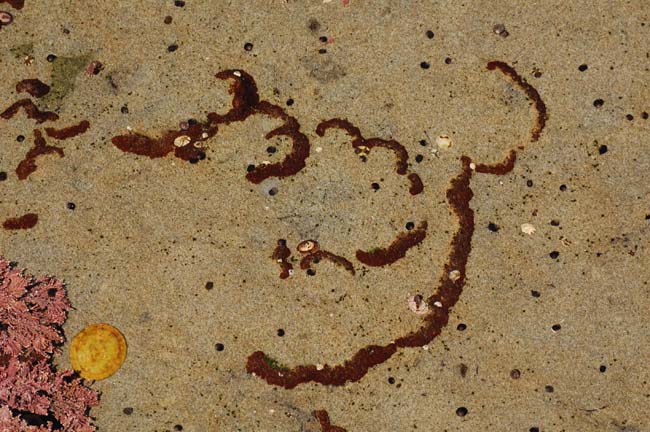
the immortal red crust
ECOLOGY
|
|
What are the processes that determine the distribution and abundance of Hildenbrandia? All crustose algae, especially Hildenbrandia spp., grow slowly and are poor competitors. However, crusts have developed mechanisms of tolerating extreme stress or extreme disturbance, which allows them to persist in zones and microhabitats where other macroalgae cannot (1, 2). In other words, crusts are found in places where they don't have to compete directly [for space] with other algae. There are more of these places than one might think. Indeed, it is reasonable (albeit hardly falsifiable) to say that crusts, Hildenbrandia spp. in particular, occupy the most primary space of any algal functional group. Some crusts flourish in zones with high productivity potential and high disturbance potential (e.g., urchin-dominated areas in the shallow subtidal). At the other end of the spectrum are Hildenbrandia spp. and lichens which seem to be adapted for living in habitats with low productivity potential (i.e., physically stressful) and low disturbance potential (2). What are the mechanisms of stress tolerance in Hildenbrandia? The physiological mechanisms underlying Hildenbrandia's ability to live in stressful environments are not well studied. The most obvious explanation is the low metabolic rate associated with its morphology and anatomy. The lack of cell differentiation and nonphotosynthetic tissue is an simple but successful strategy for persisting in stressful environments (3). Indeed, Hildenbrandia spp. is well known for its incredibly slow lateral growth rate, often <1 mm/year (3, 4, 5). In fact, such miniscule growth rates make it difficult to experimentally evaluate Hildenbrandia's physiology and fitness; it's hard to say which environmental conditions are optimal for its growth and persistence (see Overgrowth). What are the mechanisms of disturbance (i.e., herbivory) tolerance in Hildenbrandia? Hildenbrandia's remarkable stress tolerance can be understood as its primary mechanism of herbivory tolerance (6). If an animal wants to graze on Hildenbrandia, it must be prepared to put up with the same physical stresses. It must also be willing to munch on crust. The most conspicuous grazers of Hildenbrandia are limpets and littorine snails (3, 4). Hildenbrandia's tough perithallic morphology makes grazing fairly difficult. Bertness et al. (1983) report that the radulae of snails and limpets can be severely worn down by munching on Hildenbrandia. Its perithallic filaments have been shown to regenerate fairly quickly (i.e., vertical growth, when it's happening, is much faster than lateral growth). This ability to resist and regenerate makes it unlikely that a Hildenbrandia individual will ever be removed completely from the rock. Indeed, as was the case with its stress tolerance, it is difficult to experimentally evaluate Hildenbrandia's tolerance of disturbance. Its distribution and abundance do not respond very strongly to grazer manipulations (4).
|
- The word 'or' is underlined because there is no known life strategy of algae (and plants in general) that allows them to tolerate extreme stress and extreme disturbance.
- Steneck, R.S. & Dethier, M.N. 1994. A functional-group approach to the structure of algal-dominated communities. Oikos 69:3, pp. 476 - 498.
- Dethier, M.N. 1994. The ecology of intertidal algal crusts: variation within a functional group. Journal of Experimental Marine Biology and Ecology 177:1, pp. 37 - 71.
- Bertness, M.D. et al. 1983. Snail grazing and the abundance of algal crusts on a sheltered New England rocky beach. Journal of Experimental Marine Biology and Ecology 71:2, pp. 147 - 164.
- Dethier, M.N. & Steneck, R.S. 2001. Growth and persistence of diverse intertidal crusts: survival of the slow in a fast-paced world. Marine Ecology Progress Series 223, pp. 89 - 100.
- This strategy is generally called disturbance avoidance. This process corresponds to an important ecological concept, because it represents the most significant interaction between productivity potential and disturbance potential (2).

